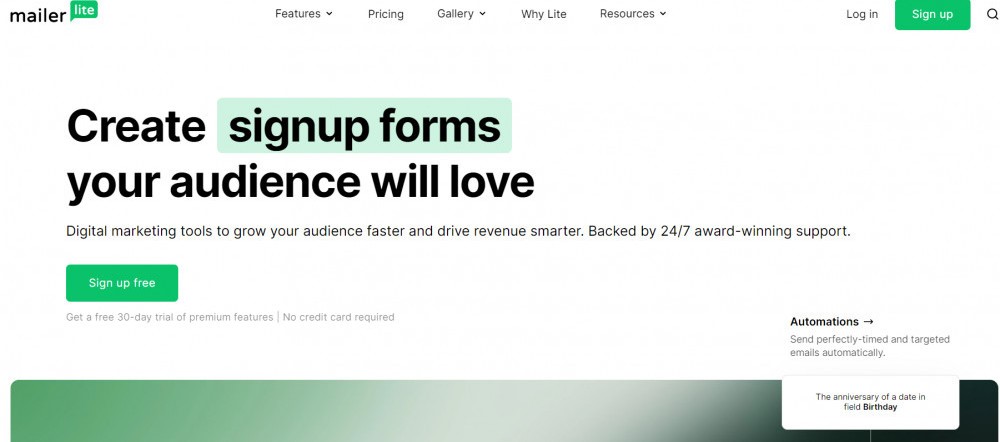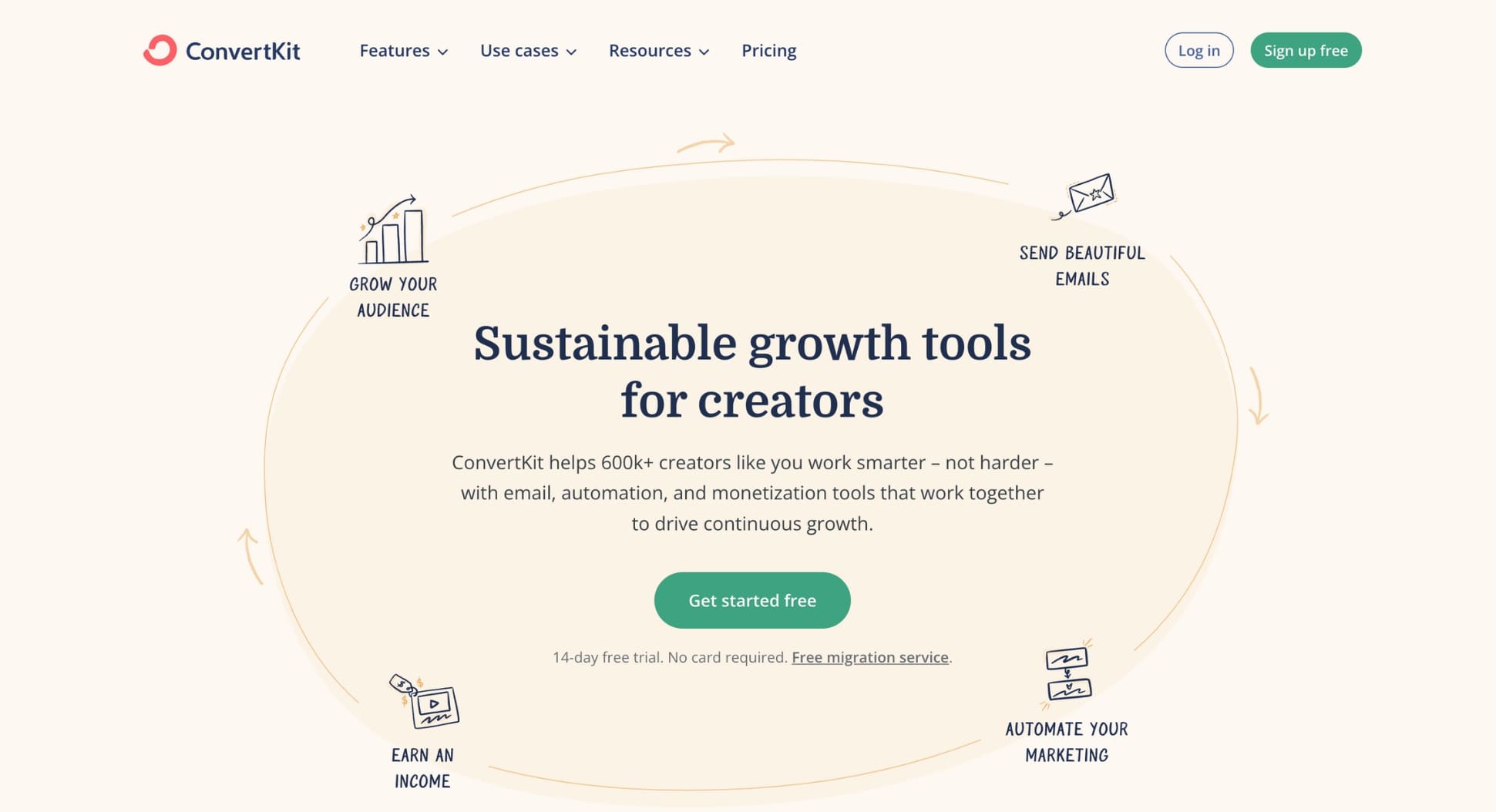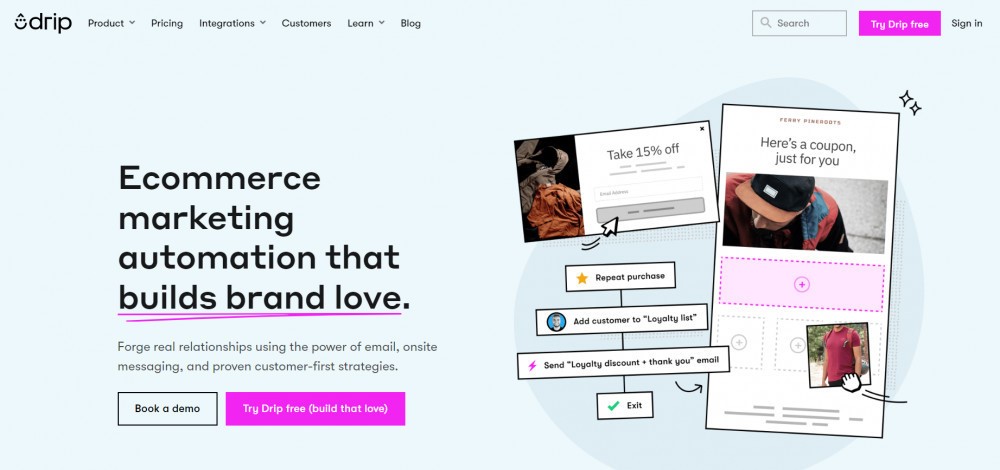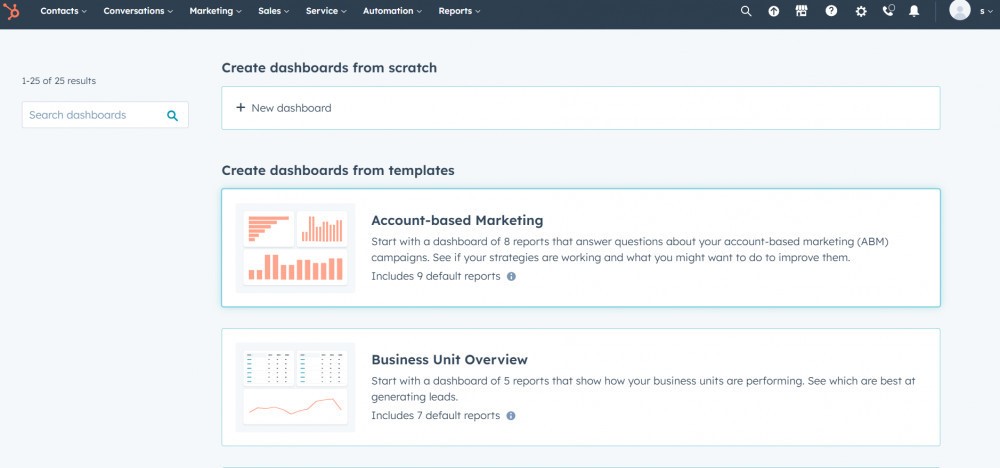Email marketing is a core part of any marketing strategy. But finding the right email automation platform for you can feel like a mission in itself. Asking yourself… “Which one is easiest to use?” “Does it have the automation I need for my style of business?” “Am I getting the best deal?”
Don’t worry, in this guide, we’ve done 95% of the legwork for you.
We’ll walk you through the five best email automation platforms so you can find the perfect platform for you.
Key considerations for the best email automation platform
Before you jump into tools…
It’s worth thinking about what type of emails you want to send and how you plan to send them so you can pick the email automation platform suited to your needs:
What kind of email marketer are you?
There’s a huge difference between a salesperson or a service-based business sending automated emails versus an e-commerce website selling physical products.
For example, store owners may want to create beautifully designed emails with powerful purchase-related email automation, while salespeople may want to send hyper-personalized text-based emails to generate new conversations.
The email automation you need from a tool will vary based on the way you do business.
How do you plan to send emails (and how often?)
- Do you want to send emails from your Gmail account? Look for tools with Gmail integration like Mailmeteor.
- Do you want to create stunning email templates? Be sure to choose an email automation platform with an easy-to-use, drag-and-drop template builder.
- Do you want to maximize email deliverability? Use a platform that has features like drop sending (or sends through Gmail servers) to maximize deliverability.
Once you’ve had a quick think about what you need from an email automation platform, let’s dive into 5 of the best tools for marketing for different needs:
The top 5 best email automation platforms
At a glance: The best email automation platforms
| Platform | Who It’s Best For | Standout Feature |
|---|---|---|
| Mailmeteor | Small businesses and entrepreneurs | Send automated email templates from Gmail |
| MailerLite | Companies looking for cost-effective email marketing | Easy-to-use interface, drag-and-drop template builder |
| Kit (ConvertKit) | Creators building online businesses | Visual email automation builder |
| Drip | E-commerce businesses | Powerful automation, intelligent segmentation |
| HubSpot | Businesses needing integrated sales and marketing tools | Comprehensive CRM integration, advanced automations |
Mailmeteor

TLDR: Mailmeteor offers a super easy way to send automated emails, follow-ups, and sequence templates from your Gmail or Google Workspace account.
With over 6 million users worldwide and recommended by Google, Mailmeteor is a trusted email automation platform to send personalized mass email automation with Gmail.
Unlike other solutions that box you into complex dashboards, Mailmeteor gives you the choice to set up your email automation from within Google Sheets or the Mailmeteor Dashboard.
And because Mailmeteor sends emails through your Gmail account (instead of email marketing platforms’ own servers), you benefit from better deliverability because it looks like a real human-sending activity to your recipient’s inbox.
Mailmeteor allows email sequences to automatically be sent out to recipients over a set number of days. You can auto-send follow-ups based on customer interactions.
What’s more, it allows you to set up ongoing campaigns that will continue sending emails until you decide to stop them.
To give you an example of how automation works…
Let’s say you have a Google Sheets spreadsheet and every time that changes (e.g., a new subscriber is added from a Google Form to the list), it will automatically send an email to that new subscriber.
This flexible approach to automation based on a Google Sheet means that you can get hyper-custom with your automation and do things like…
- Automatically send an email after someone fills out a contact form from your Gmail account.
- Send emails when you add someone to a spreadsheet. (Ideal for payment confirmations, event attendees, and more.)
- Send emails on a specified recurring date — e.g. you could send emails to your list daily, every Monday, or for special occasions like new blog posts, birthday wishes, license renewals, and more.
Beyond custom automation, Mailmeteor lets you track your results to improve your email marketing efforts.
Of course, such a simple platform does have its drawbacks… if you’re looking for a platform that offers a drag-and-drop email builder or more features beyond email marketing like landing pages, sign-up forms, and more, this isn’t the platform for you.
But if you’re looking for something easy to get started with, respects your privacy, works with and is recommended by Google, and gives you the freedom to work where you work and integrate with a bunch of tools, Mailmeteor is for you.
Pros
- Easy to use and get started with.
- Works with your Gmail account, which means you get much better delivery rates.
- Flexible (it doesn’t box you into their ecosystem).
- Easy to integrate with other tools and set up custom automation.
Cons
- Mailmeteor doesn’t have a drag-and-drop builder (you can still create beautifully designed emails by importing your HTML code).
- Mailmeteor abides by the Gmail sending limitations, which means you can only send up to 2,000 emails a day.
Pricing
- Free plan – Send up to 50 emails a day for free.
- Mailmeteor Premium – Send up to 500 emails a day for $9.99 a month.
- Mailmeteor Pro – Send up to 1,000 emails a day for $24.99 a month.
- Mailmeteor Business – Send up to 2,000 emails a day for $49.99 a month.
MailerLite

TLDR: MailerLite is best for those looking for a cost-effective, easy-to-use newsletter platform with all the features you’d expect from an email automation tool.
MailerLite offers a wide range of email marketing tools that are easy to use for both new and experienced email marketers.
It offers all the features you’d expect, like email automation, embeddable sign-up forms, segmentation, landing pages, and email templates, making it ideal for any company looking to get started with email marketing.
From our testing, we found the biggest benefit is how easy it is to use and the number of subscribers you get on the free plan (1,000).
However, it’s worth pointing out that, unlike platforms like Mailmeteor listed above, MailerLite is more aimed at sending email newsletters and broadcast marketing campaigns as opposed to targeted follow-up and sales emails.
In terms of how reputable MailerLite is as a company, the platform is used by 600,000+ businesses and often comes on top of many email marketers’ shortlists, rated 4.7/5 on G2.
It also integrates well with hundreds of marketing tools, giving you the freedom to build the system the way that works for you.
Pros
- Generous free plan.
- Good email automation options for sending email sequences.
- Easy-to-use interface.
- Simple drag-and-drop template builder.
Cons
- Limited email templates on the free plan.
- Not great for those who want to send one-off automated emails based on customer interactions.
- Doesn’t work within Gmail.
Pricing
Free plan — Send up to 12,000 monthly emails to 1,000 subscribers. And access features like the email automation builder, sign-up forms, reporting, and web page builder.
Paid plans — All MailerLite paid plans let you send unlimited emails and charge you incrementally by the number of subscribers you have, starting at $10/month for 500 subscribers. On paid plans, you get all the features on the free plan plus the ability to sell products, access better templates, and more advanced email automation features.
Kit (formerly ConvertKit)

TLDR: Kit is best for someone with a personal brand looking to promote their content with their own newsletter and monetize their audience.
Kit (formerly ConvertKit) positions itself as an email automation tool to help creators grow their businesses, which means it has specific features built for those building an online business around their personal brand.
It has a fantastic visual email automation builder, a generous free plan (up to 10,000 subscribers), and allows you to charge subscribers for your newsletter.
If you fit the ‘creator’ bill, it’s a great tool. But if you’re a larger business, it might not be the best platform for you.
In terms of their company reputation, ConvertKit is a company whose journey we have followed closely at Mailmeteor. Nathan Barry founded the company in 2013 and since then has been sharing the journey of building ConvertKit in public and has thus won the hearts of the creator community.
Right now, the platform has over 600,000+ creators using it, including Andrew Huberman, James Clear, Tim Ferriss, and many more. If you’re a creator using email as a core part of your business, this is probably the platform for you.
Pros
- Complex email automation with their visual automation builder.
- The automation it offers allows you to dig deep and get super-targeted.
- Gives you all the tools you need to take payment for your newsletter.
- Generous free plan.
Cons
- Lacks a dedicated analytics dashboard.
- As your subscribers grow, the cost can become expensive.
- The options for creating email templates are limited.
- Scalability might be an issue — it’s designed for small solo businesses.
Pricing
ConvertKit pricing depends on the number of subscribers you have.
- Free plan — Includes unlimited landing pages, email forms, and broadcasts, but you are limited to up to 300 subscribers.
- Creator — $9 per month up to 300 subscribers or $108 yearly. But adds automation, one of its most valuable features.
- Creator Pro — $29 per month for 300 subscribers or $290 yearly. This plan comes with a host of features like referral systems, subscriber scoring, and advanced reporting.
Drip

TLDR: Drip is the email automation platform for e-commerce businesses who want to maximize their email marketing efforts with powerful automation like abandoned cart emails and more.
Drip positions itself as an e-commerce email automation platform. You get all the features you’d expect from an email marketing platform, like stunning drag-and-drop templates, follow-up sequences, powerful automation, and advanced segmenting capabilities based on customer behavior, so you can send specific offers to different customers at each stage of their journey to boost conversion and maximize their lifetime value.
What’s clear from their landing page is the customer support they offer; it seems customers switch from other tools for Drip’s superior support across US and EU time zones with chat support available in less than 2 minutes.
As you’d expect from an eCommerce automation platform, it integrates seamlessly with Shopify, WooCommerce, and hundreds more tools.
The pricing plans are a little expensive though (as detailed below).
If you want a tool only for email marketing, Drip shouldn’t be your first pick compared to the other options on this list. But if you want a tool with many features aimed at eCommerce, then it might be just right for you.
Besides stellar support, Drip provides its users with plenty of educational material and content to help them make the best of their e-commerce work, as well as plenty of tutorials to increase your email marketing performance when it comes to growing your business.
Pros
- Solid email automation platform for e-commerce stores.
- Intelligent segmentation for powerful automation.
- Known for their stellar support.
Cons
- Plans only make sense for e-commerce.
Pricing
Drip has no free plan. The starting price is $39 for 2,500 contacts and unlimited email sends. Your cost increases by $10 for every 500 contacts (up to 6,000). Use Drip’s calculator to gauge your cost anywhere above that.
Hubspot

TLDR: Solid email marketing platform for businesses that want a platform that integrates with the rest of the Hubspot sales and marketing suite.
When it comes to email automation platforms, HubSpot has everything you need. From powerful automation to a drag-and-drop email template builder and the ability to segment your lists.
However, it’s worth pointing out that HubSpot has a large suite of products to help businesses with all sales and marketing-related activities, from CRM tools to social media management and website content management.
With the above in mind, that can work against you if you’re looking for a simple email marketing tool to get started with. HubSpot’s learning curve is steeper than the alternatives in this list.
However, if you’re looking for a tool that acts as a single source of truth for your marketing and sales efforts, it could be the way to go.
In terms of company reputation, HubSpot is as good as it gets. With over 216.000 compaines using it and being a publicly traded company. The platform isn’t going anywhere soon.
HubSpot has a generous free plan to get started with; however, as detailed below, if you choose to use the rest of their marketing tools, costs can add up quickly.
Pros
- Generous free plan (but make sure to check paid plans, this can add up).
- Good email automation thanks to integration with CRM features.
Cons
- Gets expensive quickly.
- The large platform can be overwhelming.
Pricing
Naturally, with a wide feature set and use cases, HubSpot’s plans are a little complicated at first glance. Here’s a simple breakdown:
- Starter plans pay €20 per month for 1,000 contacts with a selection of features to get started.
- Professional: €880 per month for 2,000 marketing contacts
- Enterprise is at €3,300 per month for 10,000 contacts
You can always purchase banks of contacts if your list grows past your limit.
The full list of features and pricing can be found on their website, and your choice of plans will hugely depend on what capabilities you look for.
Roundup: Choosing the Right Email Automation Platform
Selecting the best email automation platform hinges on factors like your business type, email marketing goals, and ease of use. We’ve covered the key considerations and reviewed five top-tier platforms to help you find the ideal fit.
-
Mailmeteor - Ideal for small businesses and entrepreneurs needing seamless email automation directly from Gmail. It offers excellent deliverability and integrates effortlessly with Google Workspace, making it perfect for personalized mass email campaigns.
-
MailerLite - A cost-effective choice for companies seeking user-friendly email marketing tools. With features like drag-and-drop templates and robust automation capabilities, it’s great for launching effective email campaigns without breaking the bank.
-
Kit (formerly ConvertKit) - Tailored for creators building online businesses, Kit excels with its visual automation builder and tools for monetizing newsletters. It’s designed to support personal brands with intuitive email management.
-
Drip - Geared towards e-commerce businesses, Drip stands out with advanced automation features like cart abandonment emails and powerful segmentation. It’s ideal for maximizing sales through targeted email campaigns.
-
HubSpot - Offering comprehensive CRM integration and advanced automation, HubSpot is perfect for businesses needing a unified platform for sales and marketing. While robust, it may require more technical expertise to fully leverage its capabilities.
Each platform reviewed here caters to specific needs, whether you prioritize simplicity, cost-effectiveness, or advanced features. Consider your unique requirements and business goals to choose the email automation platform that best supports your growth.
FAQs
What is an email automation platform?
Email automation platforms let you send emails to people at specific moments and to specific people without needing to do any work to nurture customers along your journey.
How do I create an automated email system?
Using an email automation platform like Mailmeteor allows you to build a series of emails that are sent automatically in the background without requiring any manual effort.
Does Outlook have email automation?
No, out-of-the-box it only supports schedule send. However, you can use tools like Mailmeteor for Outlook to extend this functionality.
Does Google have email automation?
No, out-of-the-box it only supports schedule send. However, you can use tools like Mailmeteor for Gmail — used by 6 million globally — to create auto-follow-ups and more.
What is the difference between email automation and autoresponder?
An autoresponder is just one type of automation: a sequence of emails sent to subscribers over a set number of days. Email automation can include email sequences, auto-follow-ups, automatic subscriber segmentation, and much more.
How to automate emails from Excel?
By uploading an Excel file to Google Sheets or downloading it as a CSV, you can automatically send emails on specific days, new cell creations, and more using Mailmeteor’s email spreadsheet automations.
How to automate emails on Gmail?
You can install an email automation plugin for Gmail. The best free option is Mailmeteor, used by 6 million Gmail users.



